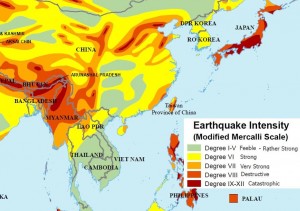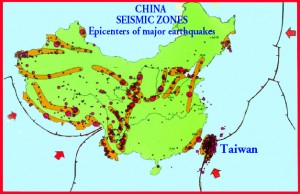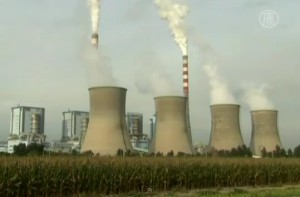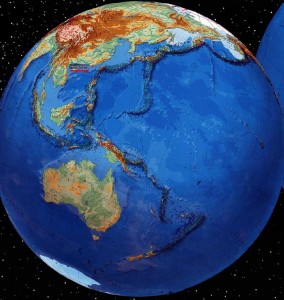Article
 In 1998 British Journalists produced a documentary called “Death on the Silk Road” which exposed massive health impacts from radiation to exposed communities by China’s nuclear weapons testing program. The cover up of the radiation impacts are of serious concern when looking at the China’s nuclear energy agenda, the world’s biggest with over 150 reactors being proposed. Is there be a similar lock down on what is happening with China’s nuclear power program, and especially if there were any major nuclear releases?
In 1998 British Journalists produced a documentary called “Death on the Silk Road” which exposed massive health impacts from radiation to exposed communities by China’s nuclear weapons testing program. The cover up of the radiation impacts are of serious concern when looking at the China’s nuclear energy agenda, the world’s biggest with over 150 reactors being proposed. Is there be a similar lock down on what is happening with China’s nuclear power program, and especially if there were any major nuclear releases?
Today, many governments throughout the world have been pushing to develop nuclear reactors and this is especially the case across Asia. One of the most disturbing moments was when the EPA first released radiation charts showing radiation levels from Fukushima. One of the charts distributed (see above) showed the first major fallout spike to reach the U.S. until late March. However, in that same chart, it showed multiple radiation spikes that were up to six times greater than from Fukushima.
Even though China embarked on a major nuclear development program several decades ago, its near lock down of accidents has been almost absolute. The last known report of an accident took place on May 31, 2008, disclosing an event that happened on May 12th where large quantities of destroyed concrete were found near a mountain between Yingxiu town and Xuankou town in the Sichuan Province. Then in a surprise move this past January, the government of Japan disclosed knowledge of a serious accident outside of Beijing in October of 2011. The international press failed to pick up on the story, letting it die. The year before this, India also underwent a number of radiation incidents including one described as a terrorist attack. Again, nearly no coverage outside of local media outlets.
And last but not least, was the 2008 bombshell, completely covered up by the US media in Japan, where an American nuclear submarine was caught spreading radiation in ports around Japan. The incident, was delinked by western media from public fallout in Japan when it was disclosed that the US had forced the Japanese government (how much arm twisting?) to allow the US military to routinely bring nuclear weapons into Japan which is against their constitution to do.
In this Washington Post article discussing Japan’s plans to make the scandal public, you can note that there is no mention of the submarine leaks in 2008, as well as plans by the Obama administration to homeport a nuclear powered aircraft carrier that set off public anger. Nor was there any mention of Japanese outrage over a series of high profile rapes by US military personnel done against Japanese women.
Should there be concerns about radiation releases when this kind of secrecy has been in place for decades?
 As anyone who attempts to do a search on China knows, there will be a huge number of official government documents that overwhelm researchers looking for critical content. This is especially the case with China’s nuclear operations. Shortly after the Fukushima disaster, the Huntington Post published an important article warning of a similar tsunami scenario for both China and Taiwan. The central government has 4 operating reactors, 2 under construction and nearly 20 more planned all within 50 miles from the 10 million people living in Hong Kong.
As anyone who attempts to do a search on China knows, there will be a huge number of official government documents that overwhelm researchers looking for critical content. This is especially the case with China’s nuclear operations. Shortly after the Fukushima disaster, the Huntington Post published an important article warning of a similar tsunami scenario for both China and Taiwan. The central government has 4 operating reactors, 2 under construction and nearly 20 more planned all within 50 miles from the 10 million people living in Hong Kong.
Background
 China has led the world in building nuclear reactors in the last 20 years. Even though there was a brief interruption and review of development plans after Fukushima the country is still looking to invest as much as $120 billion in new reactors between now and 2020. They currently have 14 operational reactors with 27 more under construction (as well as an additional 50 more being planned as well as a whopping 100 more being proposed) that will produce 60 gigawatts of electricity by 2020. Even so, nuclear energy makes up less than 3% of China’s electric output. Annual growth in electrical use in China has been over 10% with many major projects coming online from large hydro-electric facilities to major development in wind, solar and coal which makes up 83% of their electric mix. See here for detailed review of China’s nuclear program. As a result of China’s dramatic increase in the use of nuclear energy, it has been scrambling to find or buy ever greater supplies of uranium as documented by this detailed report. This US government report details the structure of China’s nuclear industry in relationship to its plans to deal with nuclear waste.
China has led the world in building nuclear reactors in the last 20 years. Even though there was a brief interruption and review of development plans after Fukushima the country is still looking to invest as much as $120 billion in new reactors between now and 2020. They currently have 14 operational reactors with 27 more under construction (as well as an additional 50 more being planned as well as a whopping 100 more being proposed) that will produce 60 gigawatts of electricity by 2020. Even so, nuclear energy makes up less than 3% of China’s electric output. Annual growth in electrical use in China has been over 10% with many major projects coming online from large hydro-electric facilities to major development in wind, solar and coal which makes up 83% of their electric mix. See here for detailed review of China’s nuclear program. As a result of China’s dramatic increase in the use of nuclear energy, it has been scrambling to find or buy ever greater supplies of uranium as documented by this detailed report. This US government report details the structure of China’s nuclear industry in relationship to its plans to deal with nuclear waste.
 The National Nuclear Safety Administration (NNSA) under the China Atomic Energy Authority (CAEA) has regulatory authority over the China National Nuclear Corporation (CNNC) which is the state owned company that builds and operates the country’s reactor fleet. As of 2009, the CNNC employed over 280,000 workers according to a New York Times article (see CNNC scandal below). CNNC, which originally designed and built the country’s first nuclear weapons is also the sole owner of the country’s uranium mining industry. It is currently involved in mining operations in many countries including Niger as well as the purchaser of uranium from Australia. In fact, CNNC even concluded negotiations to build 2 reactors for Pakistan at the end of 2011. The San Francisco based Bechtel corporation also announced that it had received contracts to work with the engineering arm of CNNC.
The National Nuclear Safety Administration (NNSA) under the China Atomic Energy Authority (CAEA) has regulatory authority over the China National Nuclear Corporation (CNNC) which is the state owned company that builds and operates the country’s reactor fleet. As of 2009, the CNNC employed over 280,000 workers according to a New York Times article (see CNNC scandal below). CNNC, which originally designed and built the country’s first nuclear weapons is also the sole owner of the country’s uranium mining industry. It is currently involved in mining operations in many countries including Niger as well as the purchaser of uranium from Australia. In fact, CNNC even concluded negotiations to build 2 reactors for Pakistan at the end of 2011. The San Francisco based Bechtel corporation also announced that it had received contracts to work with the engineering arm of CNNC.
In January 2011 a report from the State Council Research Office (SCRO) expressed concerns about the rapid development plans and the types of designs being proposed. There are currently 4 AP1000 Westinghouse reactors under construction with plans to build 8 more. As in the US, the NNSA, which works with the US NRC, is hardly independent from state company it is supposed to oversee. It should be noted that the AP1000 design wasn’t even certified in the US until 2012. In addition a wiki-leaks report in 2011 detailed high level documents about plans to focus on building China’s in house design which is considered far more dangerous. There’s also been numerous articles after a major train wreck that took place with China’s new high speed rail system suggesting that the country’s nuclear program has suffered from lack of skilled workers who could safely operate the country’s growing fleet of nuclear reactors, as well as shoddy workmanship as construction costs are nearly a third of that predicted in the US or Europe.
In a March 12th Christian Science Monitor story on China’s nuclear safety regime, covered a statement by Wang Binghua, the chairman of the State Nuclear Power Technology Corp., that said the country’s nuclear industry had 14 safety issues, but didn’t say more about what they were. Hmm. They have 14 operating reactors…
In January of 2012, the central government ordered local health officials near nuclear facilities to start monitoring radiation in water. While a month later the first environmental laws ever concerning radiation contamination around the country’s original testing area in Gansu Province were being planned. This is the area where the British Journalists said that 8 of 10 children by the late 90’s were having cleft palates.
In one of the better investigative pieces into China’s nuclear expansion, Nature magazine disclosed major industry concerns about CNNC’s use of nuclear designs from France and and US when building their own reactors. The piece also implied that the 2008 scandal with the head of CNNC who was given a life sentence, very likely included the use of substandard reactor parts.
The only known story covering a nuclear protest in China took place in December of 2011 when hundreds of fishermen protested Guangdong Province. Just 4 short paragraphs and a mixup whether the facility was nuclear or coal demonstrates what little is known about real coverage. While in a BBC story, China has entered into negotiations with Bill Gates over nuclear investment schemes.
In another rare scandal the head of the CNNC was reprimanded in 2008 over the loss of hundreds of millions of dollars planned for nuclear development. In 1996, the U.S. Export-Import bank gave China a $383 million loan in exchange for CNNC nuclear contracts that included Westinghouse. The loans fueled a huge international scandal over Pakistan distributing nuclear technologies around the world that they got from China. In the above Federation of American Scientist’s report, also detailed how China played a prominent role in selling nuclear technology to Iran which has enraged conservatives, making the Iran’s civilian nuclear energy program the most controversial nuclear security issue in the world during the last decade. The Bush administration upped the Clinton loan in 2005 giving CNNC $5 billion.
It should be noted that the one party system in China can say nothing wrong about their development of nuclear power. And this also shows with the spread of false stories that include clearly false stories about the impacts of radiation, with this example of claims about minimal damages to wildlife in Chernobyl demonstrates.
Death on the Silk Road
The half hour video of Death on the Silk Road is below. china carried out 45 nuclear weapons tests between 1964 and 1996, 22 of which were underground. In summary, the claims made are:
- Scientists weren’t allowed to investigate or monitor the health impacts from the testing program.
- 8 of 10 children evaluated showed cleft palates and other signs of radiation poisoning.
- Health impacts have not been made public
- And information about the impacts had to be smuggled out of the country to get aired.
China’s Secret Radiation Disaster – Death on the Silk Road: Part 1
China’s Secret Radiation Disaster – Death on the Silk Road: Part 2
China’s Secret Radiation Disaster – Death on the Silk Road: Part 3
News Clips
2023 Note: All Youtube videos of Chinese nuclear accidents had been removed.
Youtube: Chinese Reactor Designs are Unsafe
China’s Nuclear Faults
 China is one of the worlds most seismically active countries in the world, having suffered major damages in the past. In 1556, the Shaanxi earthquake killed over 820,000 people. It has suffered many of the worst quakes in history, with the most recent massive disaster being the 1976 Tangshan quake that killed over 240,000 people and injuring over 150,000.
China is one of the worlds most seismically active countries in the world, having suffered major damages in the past. In 1556, the Shaanxi earthquake killed over 820,000 people. It has suffered many of the worst quakes in history, with the most recent massive disaster being the 1976 Tangshan quake that killed over 240,000 people and injuring over 150,000.
Hong Kong and the Daya – Ling Ao Nuclear Facilities
China is on a major nuclear power development spree today. It has failed to prepare adequately for earthquakes or tsunami’s . Of special concern has been the construction of reactors near Hong Kong. Today there are 4 operational reactors at two facilities (Daya Bay and Ling Ao) with 2 more under construction and additional 20 being planned. These two facilities are less than 50 miles from Hong Kong (population 7 million) and Shenzhen (population 3.3 million). The $4 Billion Daya Bay nuclear project played a key role in the US controversy during the Clinton Administration’s loans that supposed led later to technology being exported to Pakistan and other country’s. France’s EDF and General Electric were the main vendors that built the facility. While the facility was in its financing and design process in 1987, the Shuitou-Xichong fault less than 5 miles from the facility was discovered which was deemed to be able to create quakes greater than 6.0. The facility was thus designed, according to officials to withstand an 8.0 quake. The timing for building the facility took a dramatic political shift with Chernobyl. Hong Kong residents clearly opposed its construction demanding that it not be built or at least so close to the city. However, the central government ignored public concerns that was coming from not just a small minority but from a majority of the public, going ahead with its construction.
However, with the dramatic impacts from the Fukushima disaster, the question is whether or not the facilities are capable of withstanding massive flooding from a tsunami. The Filipino Crustal plate that runs from Japan to the Philippine islands is one of the most active fault zones in the world. The small black dots represents historic earthquakes. The major concern here is, just as Japan underestimated potential tsunami damages, it is more than likely than all of China’s coastal nuclear facilities have done the same.
Activists in Hong Kong have called for Daya Bay’s closure immediately after Fukushima. Organized opposition has since grown with 39 groups comming together calling for the closure of Daya Bay as well as holding a major rally in Hong Kong on Sept. 18th 2011.
Beyond Daya Bay
There are five operating, two under construction and 6 more nuclear reactors planned just to the south of Shanghai with an estimated population of over 20 million people. And guess what, they are near a major fault zone. Shanghai’s city government acknowledges having quakes above 5.0, but doesn’t say more. The city is also hit on average 3 times a year with both cyclones (hurricanes) and tornadoes.
The country’s top nuclear-power developer is planning on building a 4-6 megawatt nuclear station near Chongqing, 250 miles from the epicenter of a 7.9 earthquake in 2008 that killed nearly 90,000 people in Sichuan province.
American University Report gives extensive details of Daya Bay and more.
Letter from China speaks of the recent scandals right at the top of China’s nuclear industry as well as mentioning the concerns that experts outside of China were not allowed to look at seismic safety plans at Daya Bay.
The Wall Street Journal investigation of China’s nuclear program is actually a fairly decent piece that includes the best map out on quakes and the location of the China’s nuclear facilities.
The Chongqing Nuclear museum was a secret nuclear facility that has been opened to the public to tour.


